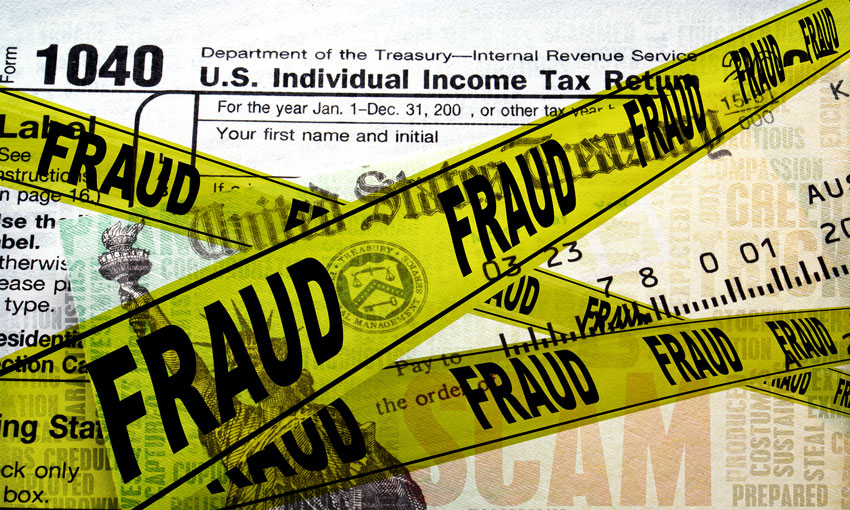|
The IRS, taxpayers and tax preparers share a common enemy: identity thieves. We all have a part to play in the fight against tax-related identity theft. Your role starts by learning the mechanics and warning signs. From there, taxpayers can take proactive steps to protect their data online and at home.
Understand How Tax Fraud Happens Dishonest individuals may steal taxpayers’ personal and financial information from sources outside the IRS, such as social media accounts where people tend to share too many details or bogus phishing emails that appear to come from the IRS or a bank. Once they obtain an unsuspecting taxpayer’s data, thieves may use it to file fraudulent federal and state income tax returns, claiming significant refunds. Paperless e-filing facilitates these scams: Thieves submit returns electronically, based on falsified earnings, and receive refunds via mail or direct deposit. Sure, the IRS maintains records of wages and other types of taxable income reported by employers, but they don’t usually match these records to the information submitted electronically before issuing refund checks. By the time the IRS notifies a victim that it’s received another tax return in his or her name, the thief is long gone and has already cashed the refund check. In addition to refund fraud, thieves may use stolen personal information to access existing bank accounts and withdraw funds — or open new ones without the taxpayer’s knowledge. Criminals are becoming increasingly sophisticated and their ploys more complex, making identity theft harder to detect. Recognize the Warning Signs Taxpayers are the first line of defense against these scams. The IRS lists the following warning signs of tax-related identity theft: Your electronic tax return is rejected. When the IRS rejects your tax return, it could mean that someone else has filed a fraudulent return using your Social Security number. Before jumping to conclusions, first check that the information entered on the tax return is correct. Were any numbers transposed? Did your college-age dependent claim a personal exemption on his or her tax return? You’re asked to verify information on your tax return. The IRS holds suspicious tax returns and then sends letters to those taxpayers, asking them to verify certain information. This is especially likely to happen if you claim the Earned Income tax credit or the Additional Child tax credit, both of which have been targeted in refund frauds in previous tax years. If you didn’t file the tax return in question, it could mean that someone else has filed a fraudulent return using your Social Security number. You receive tax forms from an unknown employer. Watch out if you receive income information, such as a W-2 or 1099 form, from a company that you didn’t do work for in 2016. Someone else may be using the phony forms to claim a fraudulent refund. You receive a tax refund or transcript that you didn’t ask for. Identity thieves may test the validity of stolen personal information by sending paper refunds to your address, direct depositing refunds to your bank or requesting a transcript from the IRS. If these tests work, they may file a fraudulent return with your stolen data in the future. You receive a mysterious prepaid debit card. Identity thieves sometimes use your name and address to create an account for a reloadable prepaid debit card that they later use to collect a fraudulent electronic refund. If you suspect foul play, contact your tax preparer immediately. He or she can help determine whether you’re a victim of tax-related identity theft and identify steps to remedy the situation. Take Preventive Measures You may wonder how many taxpayers file electronic vs. paper returns. “There are 150 million households that file federal and state tax returns involving trillions of dollars…. More than 90% of these tax returns are prepared on a laptop, desktop or even a smartphone — whether they’re done by an individual or a tax preparer. This is a massive amount of sensitive data that identity thieves would love to get access to.… With 150 million households, someone right now is clicking on an email link they shouldn’t, or skipping an important computer security update, leaving them vulnerable to hackers,” said IRS Commissioner John Koskinen in a recent statement about the Security Summit Group. (See “IRS Creates Security Summit Group” above.) How can you actively safeguard your personal data online and at home? Here are four simple ways to thwart tax-related identity theft:
Another simple way to prevent someone from filing a fraudulent return is simply to file your return as soon as possible. The IRS begins processing tax returns on January 23. If you file a tax return before would-be fraudsters do, their refund claims are more likely to be rejected for filing under a duplicate Social Security number. Join the Fight The deadline for filing your 2016 return is fast approaching. The IRS expects more than 70% of taxpayers to receive a refund for 2016, and it’s on high alert for refund fraud and other tax-related identity theft schemes. You can help the IRS in its efforts to fight tax fraud by watching for these warning signs and safeguarding your personal and financial information. This article was written by: The TMA Small Business Accounting, P.C. Their staff has been delivering professional services to small businesses in Central Indiana for over 20 years. Having worked with hundreds of small business clients, we have significant expertise with a wide variety of service businesses in Indiana. We have especially strong experience and expertise in working with businesses in the healthcare (medical, dental, etc.) and foodservice (restaurants, caterers, etc.) industries. It has been a privilege to have lived in this great United States for almost eighty-two years. In that time, I have considered it an honor and duty to have voted consistently for local, state, and national offices seekers for over sixty-one years. More importantly, I have had a direct responsibility in electing a number of significant office holders in campaigns for Mayors, Governors, Congressional Representatives, Senators, and Presidents. All of these men and women had one common denominator – LEADERSHIP!
What makes a leader a leader? There are any number of traits that added together provide leadership qualities. Finding these attributes in a person who aspires for political office, can be difficult to determine – primarily because it is in the eyes of the beholder as to what makes an outstanding candidate. Certainly the person aspiring to a particular office gives some strong indications as to his or her achievements and qualifications. Even so, we often approach a voting machine with a lack of knowledge as to the reasons for our selections. Our votes are often cast because it boils down to name recognition as to the person in whom we place our confidence. Leadership is a privilege which brings responsibilities. Strong leaders set goals and objectives and follow through with them. They listen, communicate well and lead by example. Selecting a team who work well together while being willing to take on challenges is vital. There was one civic leader who embodied all these qualities and more. William H. Hudnut III, demonstrated leadership qualities. He served as Mayor of Indianapolis for four terms – sixteen years – from 1976 – 1992. Born October 17,1932, during the Depression, he had a distinguished record of achievement over more than eighty-four years. He was Mayor of the Capital City of Indiana; Senior Pastor at Second Presbyterian Church from 1964 – 1972. In 1973, Hudnut answered the call to represent Indiana in the U.S. House of Representatives. However, it was in the capacity of Minister-Mayor that his “Leadership Qualities” blossomed and bore fruit. It has been stated that Bill Hudnut, “Built well and he cared about people.” If it were that simple, many people could have taken up the mantle of office and achieved success. No, I firmly believe that Mayor Bill brought so much more of his personal attributes to the office and embellished those which he inherited along the way. His vision transformed a city from a sleepy, stodgy, run-down entity into a vibrant, wide-awake and proud city. He has been called a “gutsy” Mayor. That means he took chances where few existed. However, Bill Hudnut was more than a risk taker. He was calculating in his choices, and weighed carefully the outcomes. He understood what it meant to “stick his neck out” because he built a lifetime of achievements based on doing what others did not expect. The results speak for themselves. He was famous for building a major-league stadium when Indianapolis didn’t have an NFL Team. He saved the Indiana Pacers NBA Basketball Team by enticing Herb and Melvin Simon to buy the franchise before it could be sold to a west coast city. He launched an effort to bring the Pan American Games to Indianapolis when other city mayors turned thumbs down because of a lack of time. The Games were a huge success because thousands of volunteers backed Hudnut’s challenge to make the Games a success. This single act brought recognition to Indy and sparked a resurgence in amateur and professional sports that is still being felt today. He believed in the city. More importantly, he believed in its people. Circle City Mall was another project that took roots and grew because he believed it was a needed element to preserve and build a vibrant downtown. The movement of business to the outskirts of the city had badly tarnished the center of Indianapolis. Hudnut called Circle City “the crown jewel” of his effort to revitalize the center of Indy. He formed a coalition of top local companies and personalities to get the job done. Hudnut was a man of humor. What other Mayors would dress-up as a 6 foot 5 inch leprechaun and dance through a whole parade? How about riding a snow plow during the middle of a terrible snow storm helping to clean the streets? Or, practicing the famous “Hudnut Hook Shot” hitting a trashcan with regularity to emphasize cleaning the city? Here was a man who didn’t always take himself seriously. His faith and experience as a minister paid dividends, as well. He knew how to motivate people and build consensus. He genuinely listened to people and was compassionate in his responses to their needs. He sought citizens with diverse backgrounds and from different cultures and then strengthened the bonds between them to form a cohesive culture. His love for the city, its people and his ability to listen to criticism and compromise when necessary brought Indianapolis out of a downward spiral and assured success where there had been little before. He was the first to admit that he had not accomplished success on his own. It took a teamwork philosophy, but there is always someone at the head of the parade – even in a green leprechaun suit to get the job done. Bill Hudnut passed away on December 18, 2016. His vision, leadership and heritage will continue to live on for many years to come. Would you prefer your retirement income to:
Wall Street financial writers try to frame retirement planning as creating a large enough pile of investments to last through retirement. This approach has merit if the retirement goal is to leave money to your heirs, but the typical main goal in retirement planning is to have enough income. Since Wall Street manufactures investments, their go-to solution to generating retirement income is to withdraw a percentage of your investments and hope it lasts. The problem is there are no guarantees with this withdrawal approach, so the suggested withdrawal percentage keeps getting lower. For years, the suggested “safe” withdrawal rate was 5%. This was generally reduced to 4% about two decades ago, but even at 4% the risk of running out of money early is as high as 32%*, so several advisors suggest that taking out 3% might be a better idea – or even limiting withdrawals to 2% from your investments each year would be prudent. The problem is most people saved for retirement with the expectation that the $500,000 they managed to put away would get them $25,000 a year and now they’re being told they should tighten their belt and settle for $10,000 in retirement income, to lessen the chance it becomes $0 down the road. The odds that you won’t run out of money – even when taking out 4% a year – are still on your side. Based on the computer simulations that Wall Streeters like to run, in most scenarios not only does your income not go down but it increases. However, the question that remains is how big of a gambler are you? The insurance world approaches retirement in a different way. Wall Street is all about managing the amount of risk the retiree retains; insurance companies transfer away the risk of income loss from the retiree to the insurer. They do this through an annuity in many different ways. Income choices from an annuity produce stable income that does not go down – even if the stock market or interest rates do – or can even automatically increase the income each year during retirement. The retiree can choose annuities where they have access to the cash value of the account and at least ensure that they (and any heirs) will get back all of what they put in. And these income choices guarantee that the income will last as long as the retiree does. These are the reasons that millions of retirees own annuities. This is not saying that a retiree should place all of their money in annuities, but it does mean one should look at their personal situation and determine how much stable income they desire and whether an annuity income choice might be prudent. * Finke, M. Pfau, W, & Blanchett, D. 2013, “The 4 Percent Rule Is Not Safe in a Low-Yield World,” Journal of Financial Planning, 26, 6: 46–55. |




